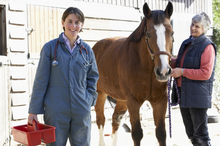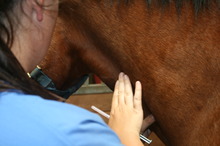Caring for your horse begins with recognizing symptoms
If a horse is limping, usually something is wrong with the limb or the foot. If the horse has a fever, it seems likely that an infection has invaded a part of the body. If the horse is kicking at its sides and rolling on the ground, colic immediately comes to mind.

Power of "horse" observation
Veterinarians develop great skill at observing a horse to detect symptoms of disease or injury.
Although recognition of these symptoms may seem simplistic, an equine owner's awareness of common equine health problems and some basic care techniques that can be put to use right then and there are invaluable in maintaining health and well-being.
Once a horse owner has arrived at a conclusion about the state of a horse's health from observing and interpreting symptoms, taking prompt action is of paramount importance. Most equine health issues will not resolve on their own and it is up to the horse owner to recognize the best method of treatment for a particular problem and to enlist the aid of professionals, including veterinarians, farriers, and others trained in treatment of horse health issues.
In some cases, a combination of treatments will be necessary. In other cases, one method of treatment will suffice to get the horse back to a status of good health.
Recognized methods of treatment for horses include the following:
- Drug Treatment
- Surgical Treatment
- Neurological Treatment
- Psychological Treatment
- Holistic Treatment
Equine drug treatment
Drug treatment for equines is a fact of life. In addition to treating infectious diseases, drugs are used to treat musculoskeletal problems, metabolic diseases, for pain relief, as sedatives for procedures, and for a number of other conditions.

Drugs are commonly used in the treatment of horses
Pain management, the treatment of various diseases, sedation for surgical procedures - a few of the many courses of drug treatment.
© 2012 EquiMed LLC
When it comes to drugs, different groups of horses have different medical needs that can be treated by the use of prescription and non-prescription medications. The needs of a performance horse differ drastically from those of a brood mare.
The goal of an owner of a competition or performance horse is to keep the horse in top physical condition while being aware of drug rules affecting the particular area of competition and staying in compliance with regulations related to the sport.
Foals have different medical needs than adult horses. Senior horses have unique medical problems, many of which are associated with aging. Some breeds of horses have medical problems unique to their particular breed.
Some horses are pasture ornaments and others are business investments and must work for a living. Whatever the age, status, and workload of the horse, it is up to the owner to work as a partner with a veterinarian and other horse medical providers to see that drug treatments of horses are properly prescribed and administered and to be on the lookout for any reactions or negative consequences of drug use.
Since horses and most other equines are much larger than other domesticated animals, a trip to the hospital or veterinarian is a difficult task, and horse owners often end up taking an active role in administering drug treatments to their equines. This includes administering both oral and injectable prescription medications and determining the effectiveness of the medications in treating the cause of the disease or condition.
Watching for any signs of drug interactions that might be harmful to the patient is also an important priority.
Surgical treatment or the horse
Injuries, severe cases of colic, and other medical conditions may make either planned or emergency surgery necessary.
When a horse shows signs or illness or disease, a veterinarian can examine the horse and determine how best to treat it. When a horse has sustained injuries or has other severe medical conditions, surgery may be the answer to save not only the horse's life, but its ability to fulfill its purpose whether as a performance horse or a pasture ornament.
For example, in colic cases where the cause is something that canât be easily fixed, surgery is the only way to treat the condition. Perhaps an intestine is twisted so tightly that circulation has been cut off, or there is an entrapment of the displaced gastrointestinal tract by another organ. Rupture of some part of the tract may also require surgical treatment.
Generally, surgery is costly, running into the thousands of dollars for routine procedures and tens of thousands or more if the horseâs condition is not straightforward or recovery is prolonged. Many surgeries go well and the horse makes an uneventful recovery.
In other cases, the horse dies or has to be euthanized within a few days because of complications. A common problem after abdominal surgery in horses is ileus, a condition in which the gut doesnât regain motility, so ingested hay and feed wonât move through the tract. If measures to resolve this problem arenât effective, the horse canât survive.
Advances in equine arthroscopic surgery
Arthroscopic surgery is gaining in importance as newer and better ways are developed to make use of this method of surgery for both diagnostic and therapeutic purposes. With the advent of the MRI, arthroscopic surgery in humans is almost exclusively therapeutic in nature. In the horse, however, arthroscopy is still commonly used to help diagnose joint disease, especially injury to soft tissue structures that will not show up with traditional radiography such as meniscal or cruciate injuries in the stifle.

Advances in horse arthroscopic surgery
Dr. David D. Frisbie performs a standing needlectomy.
© 2012 BioVision Technologies
As use of MRIs becomes more commonplace in equine veterinary medicine, and new technology allows for the larger equine joints to be imaged, then we will likely see a shift to strictly therapeutic use of the arthroscope in the horse.
At this time, however, if your horseâs lameness has been isolated to a specific joint, and radiographs and ultrasound are inconclusive, then an arthroscopic evaluation of the joint is often indicated to determine if there is cartilage or soft tissue damage that could not be visualized via conventional diagnostic methods.
Arthroscopic surgery is commonly used to treat developmental orthopedic disease (DOD) in young horses such as osteochondrosis (OD) or osteochondritis dissecans (OCD). It is also used commonly in equine athletes who have sustained chip fractures (osteochondral fragments).
One incision allows placement of the arthroscope in the joint so the surgeon can visualize the lesion, and the other incision allows the instruments to be placed in the joint to allow chip fracture removal or debridement of an OD lesion.
Another diagnostic, as well as therapeutic use of the arthroscopy, is in lacerations or puncture wounds that enter a joint or tendon sheath. The surgeon can evaluate the affected synovial structure for visible contamination or foreign bodies, as well as assess injury to the cartilage or soft tissue structures within the joint/sheath.
The arthroscope allows for high volume lavage of the contaminated/lacerated synovial structure. This lavage, in combination with local and systemic antibiotic therapies, can enhance successful resolution of infection that may be a result of the laceration or puncture.
Treatment of neurological disorders in the horse
Horses are subject to neurological disorders just like any other animal. These diseases are typically caused by viruses or parasites called protozoa. Neurological diseases present many similar symptoms in horses, so testing is often required to properly diagnose and treat these ailments.
Neurological treatment often relies on other methods of therapy such as drug treatment once the disease is identified by a veterinarian and treatment begins. In most cases, diagnosis is based on blood or cerebrospinal fluid testing, or the disease is confirmed by postmortem examination of the brain.
No treatment exists for some neurological diseases and affected horses are managed symptomatically. Although some horses recover from these diseases, many are eventually euthanized. Vaccines are available and are generally effective. Young foals need special attention, as their immature immune systems cannot yet develop immunity in response to vaccines.
Testing to determine a horse's neurological disorder is very important. Because many neurological diseases present similar symptoms, testing cerebrospinal fluid is the most commonly recommended way to pinpoint the exact cause of symptoms. Identifying which viruses or parasites are causing the horse's neurological symptoms ensures the appropriate treatment.
Although horses are subject to a number of neurological disorders, most symptoms are due to infection by Eastern Equine Encephalitis (EEE) virus, Western Equine Encephalitis (WEE) virus, Equine Herpes Virus type I (EHV-1), West Nile Virus (WNV), and Equine Protozoal Myeloencephalitis (EPM). An equine neurological PCR panel includes qualitative detection and differention of these infections.
Behaviorists and the psychological treatment of horses
Horses learn from habituation, desensitization, Pavlovian conditioning, and operant conditioning. They respond to and learn from both positive and negative reinforcement.
Humane methods, often involving various behavior modification techniques and sometimes medications, are used to help the owner solve the behavior problem.
In the past, horses were considered unintelligent, with no abstract thinking ability, unable to generalize, and driven primarily by a herd mentality. However, modern studies show that they perform a number of cognitive tasks on a daily basis, meeting mental challenges that include the best ways to procure food and developing an identification based on a social system hierarchy.
Domesticated horses tend to face greater mental challenges than wild horses because they live in artificial environments that stifle instinctive behavior while learning tasks that are not natural. Horses are creatures of habit that respond and adapt well to regimentation and respond best when the same routines and techniques are used consistently.
Some trainers believe that "intelligent" horses are reflections of intelligent trainers who effectively use response conditioning techniques and positive reinforcement to train in the style that fits best with an individual animal's natural inclinations. Others who handle horses regularly note that personality also may play a role separate from intelligence in determining how a given animal responds to various experiences.
The stress of confinement and/or isolation from other horses can lead to behavioral problems like cribbing, weaving, head bobbing, stall walking, stall kicking, self-biting, and other repetitive actions called stereotypies. These rhythmic actions by a confined or frustrated animal develop in response to physical stress leading to psychological stress.
Over the past few decades, animal behaviorists have become popular as a source for understanding and treating psychological problems in equines. Equine behaviorists include veterinarians, psychologists, and other professionals with advanced degrees in animal behavior and other behavioral and biological sciences who specialize in applying scientific principles learned from the study of behaviors in the wild, psychological learning theory, and counseling skills to help people deal with their horse's behavior problems.
Humane methods, often involving various behavior modification techniques and sometimes medications, are used to help the owner solve the behavior problem. Only veterinarians who see behavior cases can legally prescribe behavioral medications, along with other important behavior modification tools that may help many behavior problems.
Veterinary Behaviorists,a term reserved for board-certified diplomates of the American College of Veterinary Behaviorists, have the additional benefit of specific training in psychopharmacology and the medical aspects of the health of horses and how this affects behavior.
Dig deeperTM
If you enjoyed this article, you may be interested in learning more about alternative methods of equine treatment. For more of the basics, give The Healthy Equine a read.
